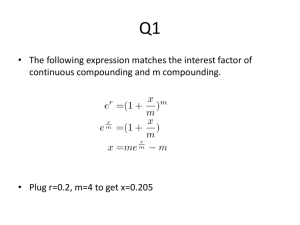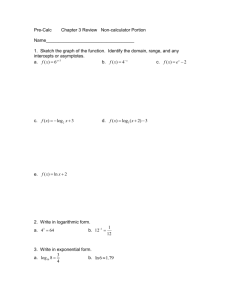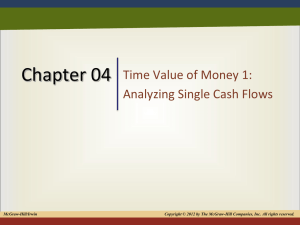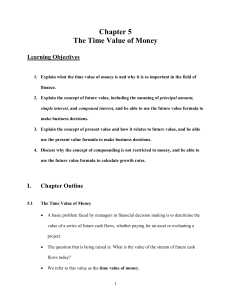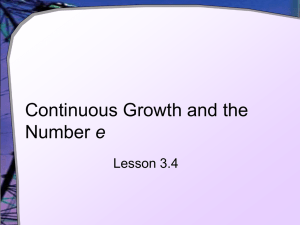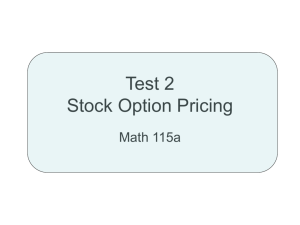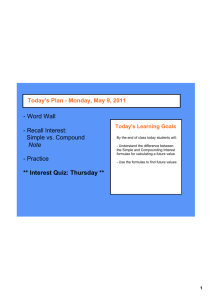Future Value
advertisement
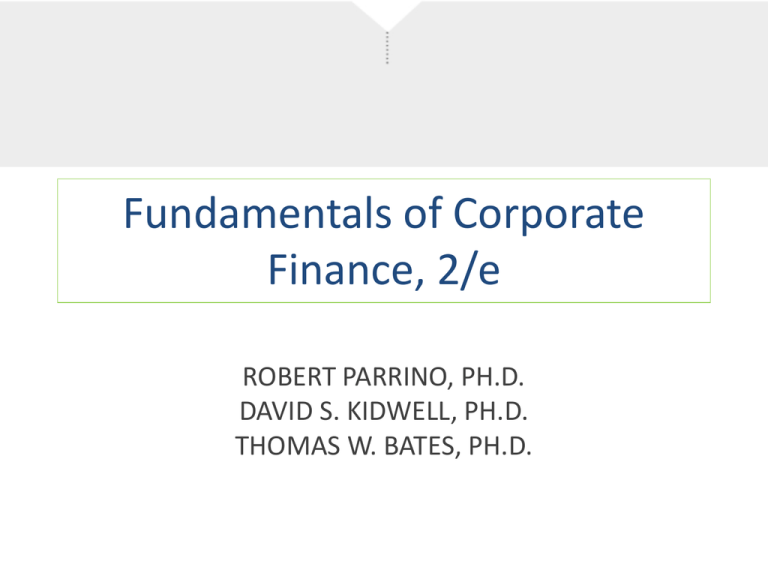
Fundamentals of Corporate Finance, 2/e ROBERT PARRINO, PH.D. DAVID S. KIDWELL, PH.D. THOMAS W. BATES, PH.D. Chapter 5: The Time Value of Money Learning Objectives 1. EXPLAIN WHAT THE TIME VALUE OF MONEY IS AND WHY IT IS SO IMPORTANT IN THE FIELD OF FINANCE. 2. EXPLAIN THE CONCEPT OF FUTURE VALUE, INCLUDING THE MEANING OF THE TERMS PRINCIPAL, SIMPLE INTEREST AND COMPOUND INTEREST, AND USE THE FUTURE VALUE FORMULA TO MAKE BUSINESS DECISIONS. Learning Objectives 3. EXPLAIN THE CONCEPT OF PRESENT VALUE, HOW IT RELATES TO FUTURE VALUE, AND USE THE PRESENT VALUE FORMULA TO MAKE BUSINESS DECISIONS. 4. DISCUSS WHY THE CONCEPT OF COMPOUNDING IS NOT RESTRICTED TO MONEY, AND USE THE FUTURE VALUE FORMULA TO CALCULATE GROWTH RATES. The Time Value of Money o EXCHANGING CONSUMPTION OPPORTUNITIES • How does a manager determine the value of a future cash-flow, whether the cash-flow is a payment to be made or income to be received? • How much is a series of future cash-flows worth today? • The price/value today of cash-flows that occur in the future is determined by the time-value-ofmoney (TVM). The Time Value of Money o CONSUME TODAY OR TOMORROW? • TVM is based on the belief that people prefer to consume goods today rather than wait to consume the same goods tomorrow An apple we can have today is more valuable to us than an apple we can have in one year. Money has a time value because buying an apple today is more important than buying an apple in one year. The Time Value of Money o CONSUME TODAY OR TOMORROW? • A dollar someone has today can be spent for consumption or loaned to earn interest • A dollar loaned earns interest that increases wealth and the ability to consume • The rate of interest determines the trade-off between consumption today and saving (investing) The Time Value of Money o TIMELINES AID PROBLEM SOLVING • Timelines are an effective way to visualize cash flows • Present cash outflows as negative values • Present cash inflows as positive values Five-year Timeline for a $10,000 Investment The Time Value of Money o FUTURE VALUE VERSUS PRESENT VALUE • Cash-flows are evaluated based on future value or present value • Future value measures what cash-flows are worth after a certain amount of time has passed • Present value measures what future cash-flows are worth before a certain amount of time has passed The Time Value of Money o FUTURE VALUE VERSUS PRESENT VALUE • Compounding is the process of increasing cashflows to a future value • Discounting is the process of reducing future cash-flows to a present value Future Value of $100 at 10 Percent Future Value and Compounding o SINGLE PERIOD LOAN • We can determine the balance in an account at the end of a period if we know the interest rate earned on the principal • If principal of $X is loaned for one period at the interest rate i, the account balance will increase to $X(1 + i)1 • The term (1+ i)n is the future value interest factor or future value factor Future Value and Compounding o TWO-PERIOD LOAN • A two-period loan is two consecutive singleperiod loans • Interest earned is added to the account at the end of the first period and the new account balance is the amount that earns the interest rate i during the second period • The account balance is $X(1 + i)1 at the end of the first period and $X(1 + i)2 at the end of the second period. Future Value and Compounding o TWO-PERIOD LOAN • The principal is the initial deposit or loan amount • Simple interest is paid on the original principal amount only • Compound interest consists of both simple interest and interest-on-interest How Compound Interest Grows on $100 at 10 Percent Future Value and Compounding o FUTURE VALUE EQUATION • The general equation to find a future value FV PV x (1 i) n n (5.1) where: FVn = future value of investment at end of period n PV = original principle (P0) or present value i = the rate of interest per period n = the number of periods, often in years Future Value and Compounding FUTURE VALUE EXAMPLE You deposit $100 in a savings account earning 10% compounded annually for five years. How much is in the account at the end of that time? FV5 $100 (1 0.10)5 = $100 (1.10)5 = $100 1.6105 = $161.05 Future Value of $1 for Different Periods and Interest Rates Future Value Factors Future Value and Compounding o COMPOUNDING MORE THAN ONCE A YEAR • The more frequently interest is compounded, the larger the future value of $1 at the end of a given time period • If compounding occurs m times within a period, the future value equation becomes FV PV x ( 1 i m ) n mn ( 5.2 ) Future Value and Compounding o COMPOUNDING WITHIN A PERIOD EXAMPLE • You deposit $100 in an account that pays 5% annually with semi-annual compounding for two years. What is the ending account balance? FV2 $100 (1+0.05 / 2)22 = $100 (1+0.025)4 = $100 (11038) = $110.38 Future Value and Compounding o CONTINUOUS COMPOUNDING • When compounding occurs on a continuous basis, the future value equation becomes FV PV e n i n (5.3) e = 2.71828, the base of the natural logarithm Future Value and Compounding o CONTINUOUS COMPOUNDING EXAMPLE • Your grandmother wants to put $10,000 in a savings account. How much money will she have at the end of five years if the bank pays 5% annual interest compounded continuously? FV $10,000 e 0.055 n $10,000 (2.71828 ) $10,000 1.284025 $12,840.25 0.055 Using Excel – Future Value and Compounding Future Value and Compounding o CALCULATOR EXAMPLE • Future Value Suppose we lend $5,000 at 15% for 10 years. How much money will we have at the end of that time? Enter Answer 10 15 -5,000 0 N i PV PMT FV 20,227.79 Present Value and Discounting o PRESENT VALUE EQUATION • General equation to find present value o FV PV (1 i) n n (5.4) • This equation has the same elements as Equation 5.1, the future value equation. They differ only in the arrangement of the elements. Here, (1 + i)n is used for division and is called the present value factor or discount factor. Present Value and Discounting Comparing Future Value & Present Value Calculations Present Value and Discounting o PRESENT VALUE EQUATION • A present value calculation takes end-of-theperiod cash flows and reverses the effect of compounding to determine the equivalent beginning-of-the-period cash flows This is discounting and the interest rate i is called the discount rate. Present value (PV) is often referred to as the discounted value of future cash-flows. Present Value and Discounting o PRESENT VALUE CALCULATION EXAMPLE • You intend to buy a BMW 330 Sports Coupe one year from today. You predict the car will cost $40,000. If your bank pays 5% interest on savings, compounded annually, how much will you need to deposit today to have $40,000 after one year? $10,000 PV $38, 095.24 1 0.05 Present Value and Discounting o PRESENT VALUE CONCEPTS • Time and the discount rate affect present value The greater the amount of time before a cash flow is to occur, the smaller the present value of the cash-flow. The higher the discount rate, the smaller the present value of a future cash-flow. Present Value Factors Present Value of $1 for Different Periods and Discount Rates Future Value and Present Value Compared Present Value and Discounting o CALCULATOR EXAMPLE • Present Value What is the present value of $1,000 to be received 10 years from now if the discount rate is 9%? Enter Answer 10 9 N i PV -422.41 0 1,000 PMT FV Finding the Interest Rate o TIME VALUE OF MONEY CALCULATIONS • Many situations require using a time value of money calculation to determine a rate of change or growth rate • An investor or analyst may want the growth rate in sales the rate-of-return on an investment the effective interest rate on a loan Compound Growth Rates o CALCULATOR EXAMPLE • Compound Growth Rate A firm’s sales increased from $20 million to $35 million in three years. What was the average annual growth rate in sales? Enter 3 N Answer i 20.51 -20 0 35 PV PMT FV Compound Growth Rates o CALCULATOR EXAMPLE • Compound Growth Rate The house at 1245 Maple St. was appraised at $247,000 in 2006 and at $173,000 in 2011. What is the average annual change in its value? Enter 5 N Answer i -6.874 -247000 0 173000 PV PMT FV The Rule of 72 o ESTIMATE THE NUMBER OF PERIODS • The Rule of 72 is used to estimate the time (number of periods) it takes for an amount to double. The time it takes for the amount to double is approximately equal to 72/i, where i equals the percentage earned each period. The Rule of 72 is fairly accurate for interest rates between 5% and 20%. The Rule of 72 o CALCULATOR EXAMPLE • Time required for an amount to double If you can earn 8% compounded annually, how long will it take for your money to double? Enter N Answer 9.006 8 -1 0 2 i PV PMT FV The Rule of 72 o CALCULATOR EXAMPLE • Time required for an amount to double If you can earn 8% compounded monthly (.667%/month), how many months will it take for an amount to double? Enter N Answer 104.32 .667 -1 0 2 i PV PMT FV
